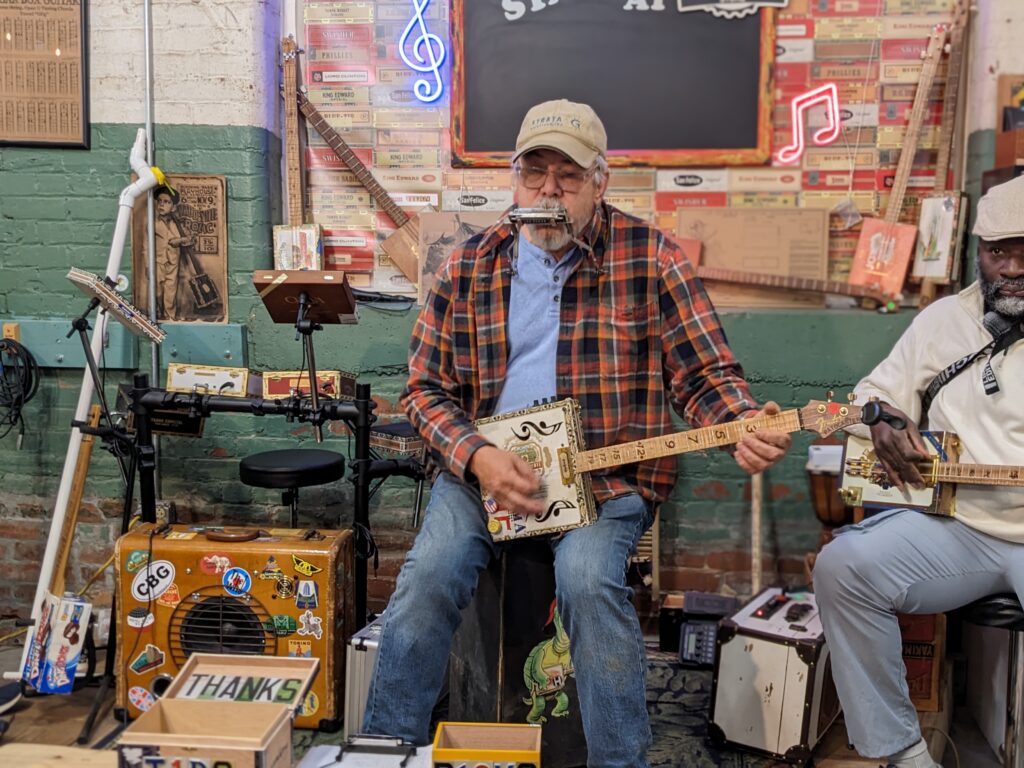Reviewed by: Emily Phillips
9 unique dresses—Embodied: Contemporary Takes on the Dress
Reading time: 8 minutes

Embodied: Contemporary Takes on the Dress is here in Huntsville for a short time—so don’t miss it!
Artist Leanna Lesley created an art exhibit with eight other artists to showcase a contemporary take on the dress. Each artist created a dress that tells a unique story, but all of the stories are bound together by a shared narrative.
We talked with Lesley about how the exhibit came to be, each dress’s story and why the exhibit is important. Each story is fascinating in its own right, but when they are all put together, the narrative is magical.
The nine artists and their dresses



1. Leanna Leithauser Lesley’s dress, Black and Tan Fantasy
- What it’s about: This dress tells the story of the Duke Ellington era of the Cotton Club and how he sought to elevate the perception of Black culture, even while he and his band were being exploited
- The materials: Freehand needlepointed, free motion stitched and hand sewn
- Interesting fact: As Leanna put the dress together, she decided that she wanted to keep the safety pins in the finished dress.
“I wanted to keep the safety pins on there as a symbolic way of protecting and securing these jazz musicians from the harm that was inflicted on them from the people who were exploiting them.”
Leanna Lesley
2. Alvina Zendejaz Montes Hill’s dress, Vestido Alvina (Gown Alvina)
- What it’s about: Alvina’s dress was inspired by her native country, Mexico, and the small town she lived in there, Delgado.
- The materials: Hand embroidery, paint, traditional Mexican clay skulls and a traditional Mexican headpiece
- Interesting fact: Alvina painted scenes from her home town of Delgado from memory.
3. Katie D’Arienzo’s dress, My Kimono
- What it’s about: Katie moved to Alabama from Honolulu, Hawaii, when she was young. She was made fun of because of her Japanese heritage, and this dress is about that heritage.
“Embracing heritage in a place that feels so far removed from my roots has given me the courage to accept myself.”
Katie D’Arienzo
- The materials: Cyanotype printing on a kimono (a symbol of longevity and good fortune) that tells the story of her life with photos of her family and more
- Interesting fact: Katie chose blue for the kimono because it symbolizes dignity and stability in Japanese culture.



4. Cynthia Wagner’s dress, The Communists are Coming for Us
- What it’s about: Cynthia experienced childhood trauma because of her mother, and she had to be hypervigilant. The eggshells on this dress are symbolic of her learning to “walk on eggshells.”
- The materials: Eggshells glued onto sheer fabric
- Interesting fact: Cynthia collected the eggshells on the dress from friends and family.
“I’ve found myself collecting one of the primary materials of the dress—eggshells—from friends and ffamily because it’s taken such a surprising number of egghsells to make the piece. It’s hard to imagine making it through all the challenges of life without the help of others.”
Cynthia Wagner
5. Tara Stallworth Lee’s dress, Trees Love Us
- What it’s about: Tara’s dress includes themes of spirituality, nature and tradition.
“Philosophies of the Jedi inform the gown, as do converging messages of Princess Mononoke and monkhood.”
Tara Stallworth Lee
- The materials: Unwanted cloth and a rejected bedsheet that underwent a process involving a dye bath with organic materials, cyanotype chemistry, her grandmother’s threads and buttons and her children’s elementary schoolwork
- Interesting fact: Tara made her own dress form from a plaster cast of her own body.
6. Erin London’s dress
- What it’s about: Erin’s dress challenges the lack of sustainability in the wedding dress industry and fast fashion as a whole.
- The materials: A bedskirt and rags
- Interesting fact: This dress has traveled many places, including Alabama, California, Illinois, Maine, Pennsylvania, Tennessee, Canada, England, France, Iceland and Scotland.



7. Michelle Reynolds’ dress, Interconnected: Remnants of Cloth and Nature
- What it’s about: This dress interweaves nature and humans’ connection to it, and incorporates mythological and biblical themes.
“My dress symbolizes both loss and a sense of hope in an age of environmental disregard.”
Michelle Reynolds
- The materials: Remnants and threads
- Interesting fact: Michelle Reynolds is a quilter!
8. Tracie Noles-Ross’ dress, Widow’s Weeds
- What it’s about: This dress is about mourning attire throughout history. “Widow’s Weeds” is a Victorian-age term for a widow’s mourning clothes, and the original form of the word was “waed” meaning “garment.” However, Tracie used the modern English word as a metaphor because weeds are generally unwanted plants.
“It is an unfortunate but interesting coincidence since widowed and older women in general are often perceived and treated as unwanted, under-appreciated and invisible members of society.”
Tracie Noles-Ross
- The materials: Unwanted fabrics that have been repurposed and plant dyed
- Interesting fact: The veil attached to the dress is her own wedding veil which she dyed black.
9. Merilee Challiss’ dress, Chrysalis
- What it’s about: This dress is all about femininity and explores the territory between sacred and profane.
“…’Chrysalis’ projects an emergent shadow of the dark feminine within.”
Merrilee Challiss
- The materials: Bras from thrift stores that she cut apart, stuffed and joined
- Interesting fact: This dress began in 1999, and the original project was named “S(mother).”
How it all came together

Leanna Lesley was the artist who brought all these artists and their dresses together. Leanna is a needlepoint artist and has a 30-piece jazz portrait exhibition that has traveled to many places. But, she craved a project that was more sculptural.
She wanted to tell the story of Duke Ellington and the Cotton Club sculpturally, but couldn’t decide what she wanted to put the story on. Then, in the 2019, the thought occurred to her to tell the story on a dress.
She started on the project when the pandemic hit, and she contacted some of her artist friends. Eventually, eight other artists joined her to create Embodied.
“It just started falling into place. It was the most dramatic-free process I’ve been inolved in. Everyone had a distinct story to tell and everybody jumped right on it.”
Leanna Lesley
She decided to curate the exhibit herself after talking to some who didn’t have interest in curating it.
“I thought, ‘You know what, I should curate it because I’m really excited about it and it should be out there for people to see.'”
Leanna Lesley
Thus, the Embodied exhibit was born.
The shared narrative

When Leanna was creating the exhibition statement for Embodied, she got stuck after a little while. She pulled up each individual artist’s statement to help her finish it, and realized something peculiar.
Even though each story was completely different, there were common words among all of them.
“All our stories are completely different, and yet the words we were using were so similar like ‘discarded,’ ‘nature,’ ‘motif,’ ‘exploitation,’ ‘death,’ ‘assembalge of remnants…’ There were so many words that kept showing up and showing up and showing up about nine completely different stories.”
Leanna Lesley
She decided that those words would be the last part of the exhibition statement, put together in a dress form.
“The nine stories that we were telling were so similar and so different and it was evident in these words. It was goosebump-y.”
Leanna Lesley
Where you can see it

You can see the Embodied exhibit at the Union Grove Gallery on the University of Alabama in Huntsville campus. Embodied is free and open to the public, and it will be at the Union Grove Gallery from October 3-November 4. The gallery hours are Mondays and Wednesdays 3PM-4:30PM and Fridays 11AM-1PM, or by appointment.
The reception for the exhibit will be held this week.
- Location: University Cir, Huntsville, AL 35816
- Time: Thursday, October 20, 5-7PM
- Website
After its time at UAH, the Embodied exhibit will be traveling. It will be at the Gadsden Museum of Art next summer, and there will be more artists added to the lineup.
Looking for more art exhibits in Huntsville? Here’s our guide to 7 art galleries in Huntsville for every art lover.
Have you seen the Embodied exhibit? Let us know by tagging us on social media @hvilleblast or by using our hashtag #hvilleblast.



